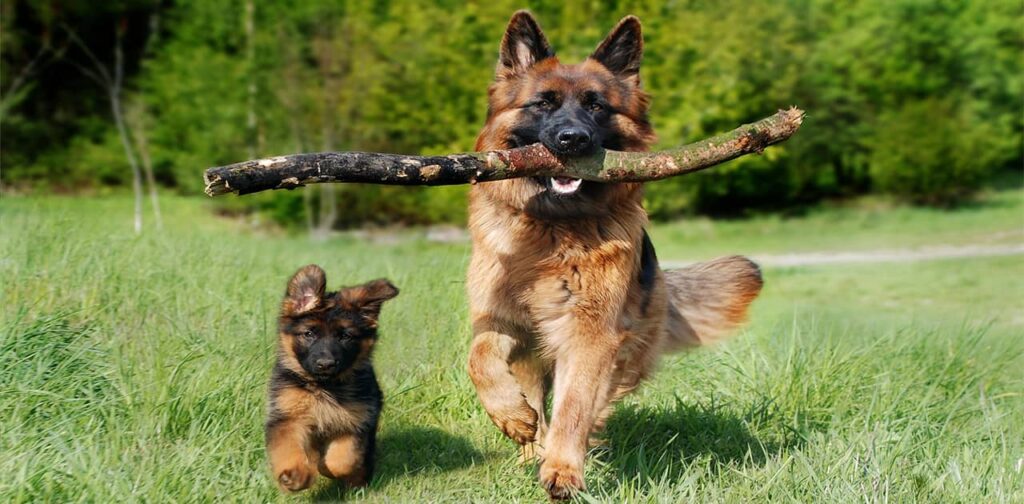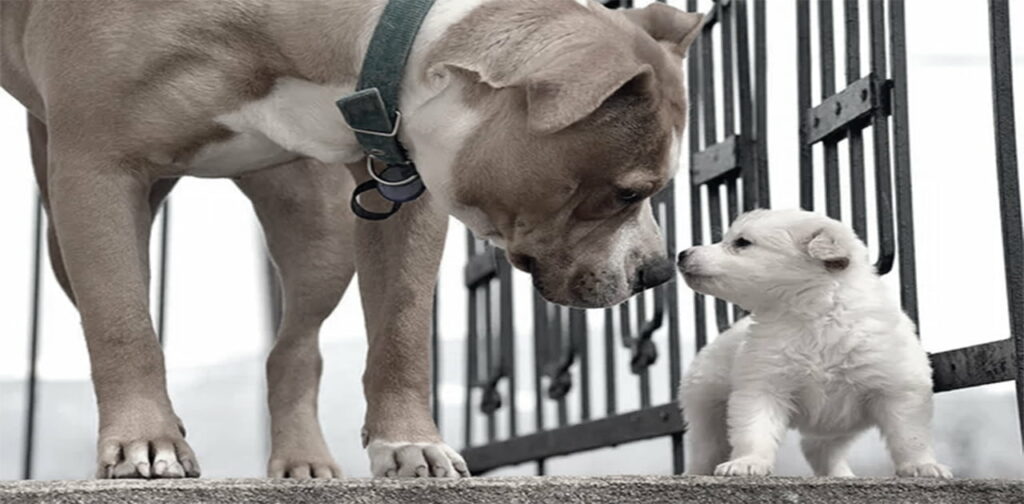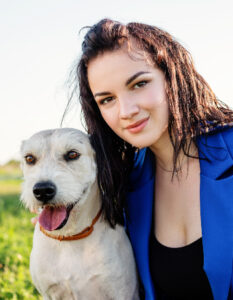We all dream of seeing our pets to be best friends forever. Taking in a new puppy as an adult dog owner has its own set of challenges. Dogs are often protective of their owner and territory. Your adult dog or puppy may not want to share your attention.
As a result, rivalry can arise between them resulting in aggressive behavior, injury, or separation anxiety. It is important to follow an effective step-by-step guide on how to introduce a puppy to an older dog to create and foster an everlasting friendship between both dogs.

How to Introduce a Puppy to an Older Dog
I am Jessica Comstock. As an experienced breeder, I have worked with many dog owners to solve this issue of how to introduce a puppy to an older dog.
Through my 7 years of experience, I have come up with 9 easy and simple steps to make your puppy and adult dog best friends.
9 Easy Steps on How to Introduce a Puppy to an Older Dog
A step-by-step guide can make this daunting process a simple and enjoyable experience for everyone.
Step 1: Meet on neutral ground
Take both the puppy and the adult dog to unfamiliar places, so that they do not feel threatened or act territorial, giving both dogs a chance to meet in a neutral setting. You can pick a park or a public location that is unexploded by your puppy and the adult dog. Be around our puppies to make them feel safe.
Step 2: Start with a fence meeting.
Try introducing them while they are safely separated by a barrier. This will help in avoiding direct contact, tension or aggression. You can use a fence or a gate as the barrier.
Now your puppy and the adult dog can easily see and sniff each other which will make them familiar to each other.
Step 3: Try parallel walking
Equip both dogs with comfortable collars or harnesses and sturdy leashes. Beforehand, ensure both are leash trained. Try walking in a familiar area to the dogs. Walk a little distance from each other.
This way you can prevent direct interaction and be overwhelmed by the proximity of the other while letting both of them be familiar with each other. Keep up a comfortable walking pace to the same direction.
Meanwhile, observe the body language of both. Body language such as relaxed body posture, wagging tails, and friendly sniffing, indicate that the distance between them is appropriate. Adjust based on your observation. Decrease the distance gradually and observe their reaction.
Lastly, end this experience on a positive note by praising and rewarding both dogs.
Step 4: Offer Sniffing Opportunities.
Choose a place free from distractions or sources of stress. Put leashes on both dogs to ensure safety. Introduce the puppy and the adult dog to each other’s toys to get them familiar with each other’s scent. Look for positive signs and body language.
Now gradually introduce them to each other while they are on the leash and sniff each other. Keep a close eye on their body language. While monitoring their approach, encourage positive behavior with rewards.
Step 5: Look for positive signs.
In many possible cases, the dogs may not get along that easily. Therefore, you may have to repeat the whole process. Start from the beginning and gradually introduce them to each other. Slowly they will get acquainted with each other’s presence.
Watch for signs of curiosity, calmness, and friendliness from both dogs. These signs indicate that they are comfortable with each other’s presence. Examples of positive signs include relaxed body language, wagging tails, and playful behavior like bowing or bouncing.
The positive signs are signals for you to move forward in the process. While the absence of positive signs is the signal to slow down the process.
Step 6: Move to home ground
Once you’re done with meaning both dogs are familiar with each other try to let them explore each other’s living area. Closely monitor their attitude. Try starting with an older dog’s home territory.
This will help them keep calm during the introduction phase as older dogs will feel more comfortable and confident. You can bring the puppy to the older dog’s house for playtime under supervision.
Step 7: Meet in the house
Now you can let both dogs stay in the same house. Start with a short duration of playtimes, and gradually increase the time. Do not forget to provide each dog with their living area or crate to avoid rivalry. This will help prevent conflict and territorial aggression among both.
Step 8: Supervised interactions
Your adult dog is stronger in comparison to your puppy and is more likely to show signs of aggression. Your puppy may also show such signs like aggressive biting. In such a situation intervention is important.
You must ensure the safety and security of both dogs through supervision and necessary intervention. Always supervise them and be alert to quickly respond to any signs of tension or aggression. To keep the interactions positive, keep rewarding them with treats and praises.
Step 9: Gradual integration
As of step 9, you have already gotten both dogs familiar and friendly with each other. Now you can increase their time together gradually. This gradual increase will allow both dogs to adjust to each other’s presence and develop a positive relationship over time.

Tips for Introducing a New Puppy to Your Dog
- Take your puppy out on regular walks where they can get exposed to other dogs naturally.
- Pay attention to both dogs equally
- Ensure both are comfortable in their environment
- Keep the living area separated to foster a sense of comfort and safety for both.
- Spend time with both dogs and let them know they are loved.
- Keep a handful of treats and toys to reward their friendly behavior.
Conclusion
While it is very important for both your dogs to get acquainted with each other, you must not rush the process as there is a lot of consideration to take place.
For the comfort, safety, and long-lasting friendship between both dogs, it is important that you follow a proper technique of introduction.
Furthermore, staying patient and consistent with the process can deliver better relationships among both dogs.





